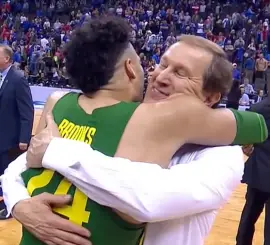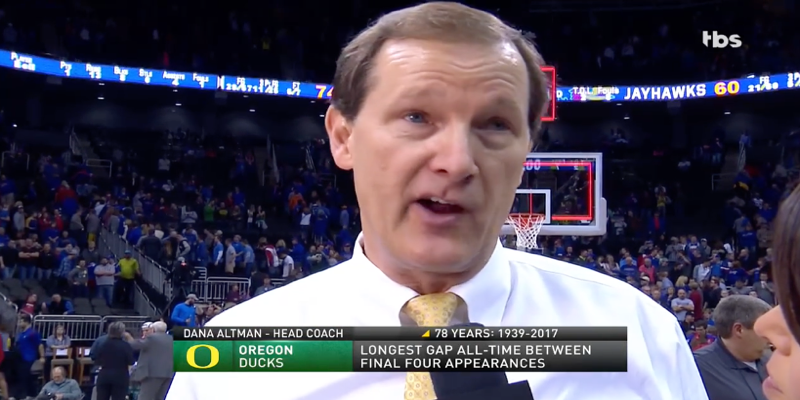A lot will be written about the Tall Firs of 1939 this week. Years ago, I interviewed guard John Dick who started on that squad. Dick, who grew up in The Dalles, went on to become an Admiral in the Navy and later retired in Eugene, where he lived until his death in 2011. Oregon’s ride back to the Final Four has been long but in a lot of ways, very similar to the route that coach Howard Hobson’s team took to get there.
Like the 1939 team, Oregon’s road to this year’s Final Four was led by guards and one dominant big man. Back then they had Dick, point guard Bobby Anet from Astoria and Slim Wintermute, from Longview, Washington. This year it’s Tyler Dorsey, Dillon Brooks and Jordan Bell from Long Beach, California.

Dillon Brooks and Dana Altman have delivered a special season for Duck fans.
Photo Credit: Video
The makeup of the size of both Oregon squads is also eerily similar. Wintermute and Bell are 6′ 8″ and 6′ 9″, and Brooks and Dick are both 6’5″ and 6′ 4″. It’s Anet at 5′ 9″ and Dorsey at 6′ 3″ where the biggest difference in stars occurs. But despite the 78-year gap in Oregon’s appearances, you still don’t need a 7-footer to win – even in today’s game. (Yes, we all know Brooks is listed at 6′ 6″ but as several sources have noted, that’s in shoes.)
Both took big early season road trips
An early season cross-country road trip of the Tall Firs set them up for the rest of the year just as this year’s team played in Hawaii and at Baylor against good competition in the preseason.
In ’39, coach Hobson made sure Oregon was battle tested by taking them on a cross-country train trip to NYC where they lost to CCNY, 38-36, in front of 16,000 fans at Madison Square Garden.
On the way home, they played in Detroit, Cleveland, Buffalo, Philadelphia, Peoria, Ill., Chicago, Des Moines, and San Francisco. Their 6-3 record on that trip proved they could hold their own against anyone, anywhere.
Both were led by Hall-0f-Fame-level coaches

Dana Altman is following in the footsteps of Oregon’s Hall-of-Fame coach Howard Hobson.
Photo Credit: Gary Breedlove
Hobson was inducted into the Basketball Hall of Fame in 1965 when current coach Dana Altman was six years old. But, as we’ve noted several times here, Altman is on pace for more than 800 victories at three programs he built himself (Kansas St., Creighton and Oregon). Only eight coaches in history have won more than 800 games.
If he chooses to coach another eight to nine years, he’ll likely wind up inside the top 10 in all-time wins. The Kansas win tied him with Dr. Tom Davis and pushed him past Georgetown’s John Thompson. In five to six years he’ll be inside the top 15 all-time. Great coaches matter. Oregon’s had a few of them. Hobson and Altman are at the top of that list.
Even the defenses are similar
Hobson switched his defense from a man-to-man defense to a zone from possession to possession to keep the opposing offense off balance. His defenses were known for pressuring and trying to create turnovers to get the ball into the speedy Anet’s hands to start the fastbreak. Altman now switches defenses within a single possession for the same purpose: to confuse the offense and give his defense any advantage he can get.
Watercooler notes
Ernie Kent’s two Elite 8 teams both lost to the eventual title winners Kansas and Florida.
Dr. James Naismith was in attendance when Oregon beat Ohio State for the first-ever NCAA title.
L.H. Gregory, The Oregonian’s sports editor at the time, gave Oregon the nickname “Tall Firs,” because of its tall front line. Dick and Oakridge’s Laddie Gale were both 6′ 4″ and Wintermute was the center 6′ 8″.
During the title game, the trophy was on display at the scorer’s table when Anet dove for a loose ball, knocked the trophy over and broke the player off the top of the trophy. Scroll down in this link; the photo reveals the trophy being held at the bottom and the player on top held onto the trophy during the presentation. And there is a video of Oregon’s 1939 team below that.
Bob Rickert
Lake Oswego, Oregon
Top photo from Video
Related Articles:
Oregon Enters Playoffs Better Off Than Last Year
Will The Coaching Carousel Kill Oregon's CFP Chances?
The Playoff Formula Hasn't Changed
Oregon Aims to Bury Dawgs, Punch Playoff Ticket in Rivalry Clash
Huskies Are the New Beavers, Stay In Your Lane Kiffin, and the Civil Apple Cup War
Oregon Football: The X-Factor Vs. Washington
A native Oregonian, Bob’s spent 16 years covering Duck football and basketball for AOL Fanhouse, OregonLive and Rivals.com. He’s also hosted a sports talk show on ESPN Radio and led marketing for the Oregon Sports Hall of Fame.

